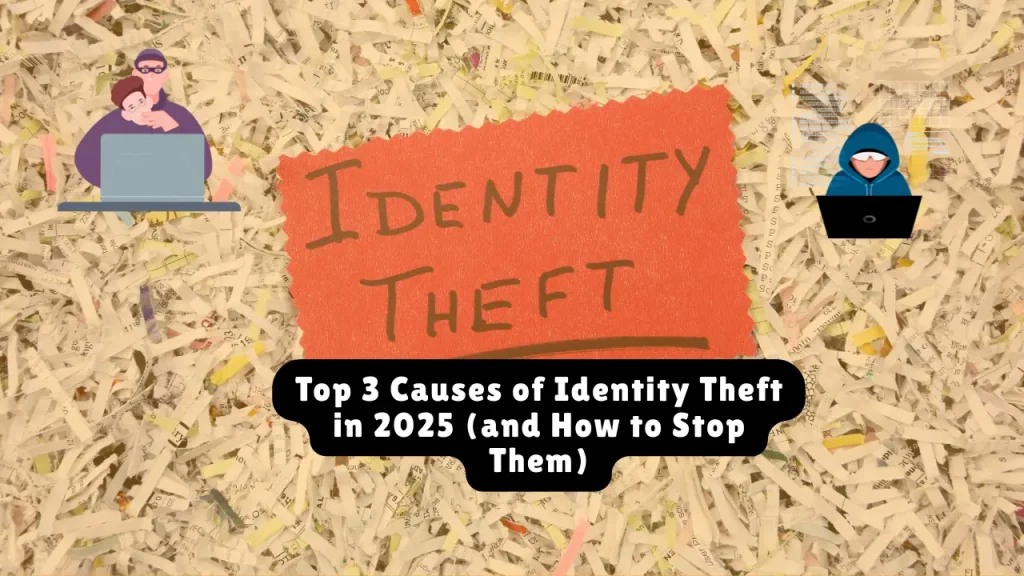Top 3 Causes of Identity Theft in 2025 (and How to Stop Them)
Identity theft is surging in 2025, with a staggering 365,758 cases reported in Q1 alone—a 24% increase from the previous quarter. From phishing emails to breached databases and stolen mail, criminals are constantly refining their tactics. Understanding the three most common causes of identity theft is crucial to protecting your financial, medical, and personal life.
Key Insight: According to the Federal Trade Commission (FTC) and leading cybersecurity firms, over 90% of identity theft cases in 2025 stem from three primary sources:
Phishing attacks, data breaches, and physical document theft.
Let’s break them down, with real-world examples, expert advice, and modern prevention tips.
Table of Contents
1. Phishing, Smishing, and Vishing (Social Engineering Attacks)
How it Works:
Cybercriminals impersonate trusted institutions—banks, HMRC, healthcare providers, or delivery services—using email (phishing), SMS (smishing), or phone calls (vishing). Victims are lured into clicking malicious links or revealing credentials like passwords and Social Security numbers.
2025 Trends:
- 40% of identity theft cases originated from phishing-style attacks.
- Voice-cloning AI is powering realistic vishing scams. 1 in 4 Americans has encountered such fraud.
- Phishing remains the most reported cybercrime in FBI’s IC3 reports.
Expert Insight:
“Sophisticated phishing and voice cloning make traditional caller-ID trust obsolete. Multi-factor authentication and ongoing user education are now critical.”
— Cybersecurity Unit, Weber State University
Prevention Tips:
- Verify contacts independently: Never click links or call numbers in unsolicited messages.
- Enable MFA: Multi-factor authentication blocks 99% of automated attacks.
- Use email authentication tools: Protocols like DMARC prevent spoofed emails.
- Educate your staff/family: Pretexting and deepfakes blur the line between real and fake.
Related article: Minimum Sentences for Identity Theft
2. Data Breaches and Synthetic Identity Fraud
How it Works:
Hackers infiltrate databases of corporations, hospitals, or payroll providers, stealing troves of sensitive data. In 2025, 69% of breaches exposed SSNs, many sold for as little as $70 on the dark web.
Real-World Damage:
- A 2025 payroll data breach exposed 36 million records, fueling a wave of synthetic identity fraud.
- Synthetic fraud (combining real SSNs with fake data) rose 153% in 2024, costing auto lenders $2 billion.
- Healthcare identity theft alone is costing victims $5 billion annually, via fraudulent claims and service misuse.
Expert Insight:
“Synthetic identity fraud is the fastest-growing financial crime today. Auto lending, healthcare, and fintech sectors are being targeted at scale.”
— Shai Cohen, SVP at TransUnion
Prevention Tips:
- Monitor the dark web: Tools like Identity Guard scan black markets for compromised data.
- Freeze your credit: Prevent unauthorized loans/accounts at Equifax, Experian, and TransUnion.
- Use IRS IP PINs: Lock your tax returns against fraudulent filings.
- Adopt zero-trust security (for businesses): Encrypt PII, audit third-party vendors.
Related article: How to See All Accounts Associated with Your Social Security Number?

3. Physical Document Theft and Mail Interception
How it Works:
Despite the digital age, 43% of identity theft victims report stolen wallets, mail, or paper records as the source. Common targets include:
- Driver’s licenses
- Pre-approved credit card offers
- Tax forms and insurance documents
Criminals use these to open new accounts, file fraudulent tax returns, or receive medical services.
Shocking Stats:
- 51% of new-account fraud involves someone the victim knows—often a family member misusing a child’s SSN.
- 17% of cases in 2022 stemmed from discarded or stolen physical documents.
Prevention Tips:
- Use a cross-cut shredder: Destroy old bills, medical documents, and bank statements.
- Secure your mailbox: Opt for locked boxes or switch to paperless billing.
- Retrieve mail promptly: Especially during tax season or benefit renewal cycles.
- Check your credit reports weekly: Use AnnualCreditReport.com for free checks from all bureaus.
Emerging Threats in 2025
Aside from the top three causes, identity theft is evolving with the help of AI and automation. Here are new threat vectors to watch:
- Medical Identity Theft: Stolen insurance credentials used for fake procedures or prescriptions.
- Credential Stuffing: Bots test stolen username/password pairs across banking, retail, and social platforms.
- Synthetic IDs: Fraudsters create entire personas using real SSNs combined with fake names and addresses.
Proactive Defense: Your 2025 Identity Protection Checklist
Here’s how to bulletproof your identity today:
Lock Down Sensitive Data
- Never carry your SSN card.
- Share your personal info only when absolutely necessary.
Use Smart Tech
- Enable biometric logins (Face ID/Fingerprint).
- Use password managers like Keeper® for unique, encrypted credentials.
- Subscribe to services like Aura or LifeLock: They offer dark web scans, breach alerts, and up to $1 million in identity theft insurance.
Monitor Continuously
- Set fraud alerts with all three credit bureaus.
- Watch bank statements for suspicious activity.
- Monitor your medical records via health portals.
Final Takeaway
Phishing, data breaches, and physical document theft drive 90% of identity theft cases in 2025—but you can slash your risk with proactive digital hygiene, smart monitoring tools, and a strong awareness of evolving threats.
Your Social Security Number is your financial DNA—protect it like your life depends on it.
Resources & Further Reading
- FTC IdentityTheft.gov – Free recovery plans and reporting.
- Javelin Strategy’s 2025 Identity Fraud Study – Expert research on fraud trends.
- Annual Credit Report – Free weekly credit reports.
- Aura Identity Protection – Monitoring, alerts, and identity insurance.
About the Author

Sarah Klein, JD, is a former consumer rights attorney who spent years helping clients with issues like unfair billing, product disputes, and debt collection practices. At All About Lawyer, she simplifies consumer protection laws so readers can defend their rights and resolve problems with confidence.
Read more about Sarah
